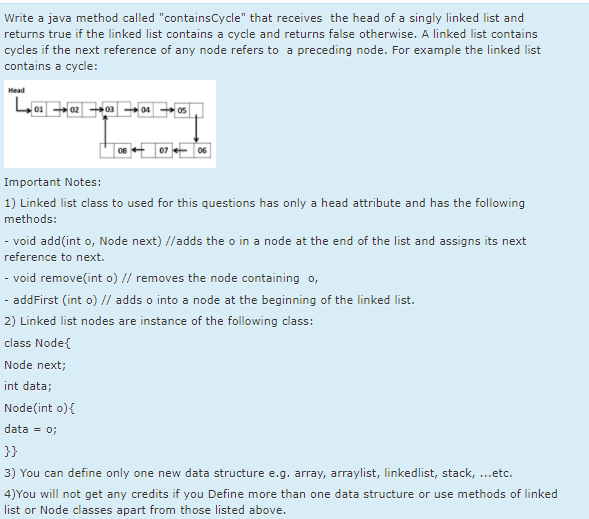Write a java method called "containsCycle" that receives the head of a singly linked list and returns true if the linked list contains a cycle and returns false otherwise. A linked list contains cycles if the next reference of any node refers to a preceding node. For example the linked list contains a cycle:
Write a java method called "containsCycle" that receives the head of a singly linked list and returns true if the linked list contains a cycle and returns false otherwise. A linked list contains cycles if the next reference of any node refers to a preceding node. For example the linked list contains a cycle:
Database System Concepts
7th Edition
ISBN:9780078022159
Author:Abraham Silberschatz Professor, Henry F. Korth, S. Sudarshan
Publisher:Abraham Silberschatz Professor, Henry F. Korth, S. Sudarshan
Chapter1: Introduction
Section: Chapter Questions
Problem 1PE
Related questions
Topic Video
Question
data structure-JAVA

Transcribed Image Text:Write a java method called "containsCycle" that receives the head of a singly linked list and
returns true if the linked list contains a cycle and returns false otherwise. A linked list contains
cycles if the next reference of any node refers to a preceding node. For example the linked list
contains a cycle:
Head
Important Notes:
1) Linked list class to used for this questions has only a head attribute and has the following
methods:
- void add(int o, Node next) //adds the o in a node at the end of the list and assigns its next
reference to next.
- void remove(int o) // removes the node containing o,
- addFirst (int o) // adds o into a node at the beginning of the linked list.
2) Linked list nodes are instance of the following class:
class Node{
Node next;
int data;
Node(int o){
data = 0;
}}
3) You can define only one new data structure e.g. array, arraylist, linkedlist, stack, ...etc.
4)You will not get any credits if you Define more than one data structure or use methods of linked
list or Node classes apart from those listed above.
Expert Solution
This question has been solved!
Explore an expertly crafted, step-by-step solution for a thorough understanding of key concepts.
Step by step
Solved in 2 steps

Knowledge Booster
Learn more about
Need a deep-dive on the concept behind this application? Look no further. Learn more about this topic, computer-science and related others by exploring similar questions and additional content below.Recommended textbooks for you

Database System Concepts
Computer Science
ISBN:
9780078022159
Author:
Abraham Silberschatz Professor, Henry F. Korth, S. Sudarshan
Publisher:
McGraw-Hill Education

Starting Out with Python (4th Edition)
Computer Science
ISBN:
9780134444321
Author:
Tony Gaddis
Publisher:
PEARSON

Digital Fundamentals (11th Edition)
Computer Science
ISBN:
9780132737968
Author:
Thomas L. Floyd
Publisher:
PEARSON

Database System Concepts
Computer Science
ISBN:
9780078022159
Author:
Abraham Silberschatz Professor, Henry F. Korth, S. Sudarshan
Publisher:
McGraw-Hill Education

Starting Out with Python (4th Edition)
Computer Science
ISBN:
9780134444321
Author:
Tony Gaddis
Publisher:
PEARSON

Digital Fundamentals (11th Edition)
Computer Science
ISBN:
9780132737968
Author:
Thomas L. Floyd
Publisher:
PEARSON

C How to Program (8th Edition)
Computer Science
ISBN:
9780133976892
Author:
Paul J. Deitel, Harvey Deitel
Publisher:
PEARSON

Database Systems: Design, Implementation, & Manag…
Computer Science
ISBN:
9781337627900
Author:
Carlos Coronel, Steven Morris
Publisher:
Cengage Learning

Programmable Logic Controllers
Computer Science
ISBN:
9780073373843
Author:
Frank D. Petruzella
Publisher:
McGraw-Hill Education